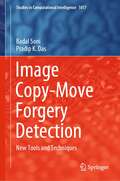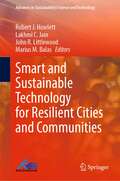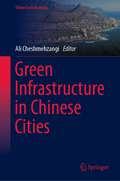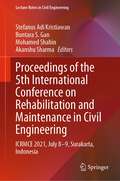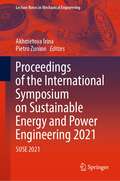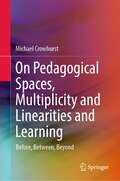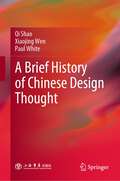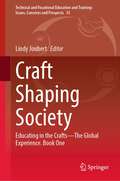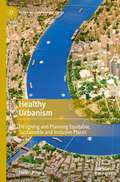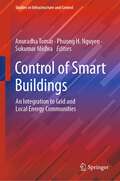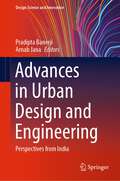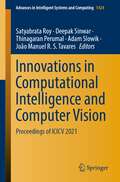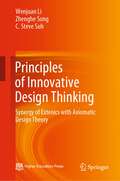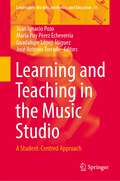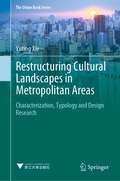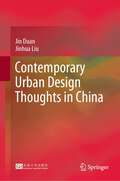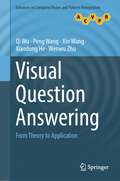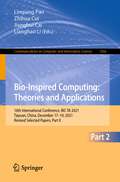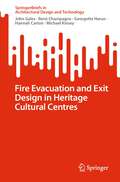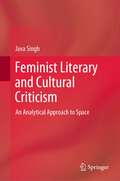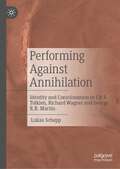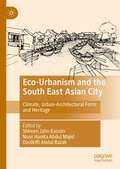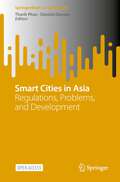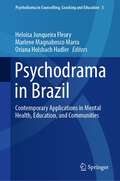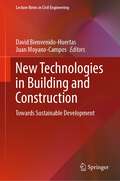- Table View
- List View
Image Copy-Move Forgery Detection: New Tools and Techniques (Studies in Computational Intelligence #1017)
by Badal Soni Pradip K. DasThis book presents a detailed study of key points and block-based copy-move forgery detection techniques with a critical discussion about their pros and cons. It also highlights the directions for further development in image forgery detection. The book includes various publicly available standard image copy-move forgery datasets that are experimentally analyzed and presented with complete descriptions. Five different image copy-move forgery detection techniques are implemented to overcome the limitations of existing copy-move forgery detection techniques. The key focus of work is to reduce the computational time without adversely affecting the efficiency of these techniques. In addition, these techniques are also robust to geometric transformation attacks like rotation, scaling, or both.
Smart and Sustainable Technology for Resilient Cities and Communities (Advances in Sustainability Science and Technology)
by Lakhmi C. Jain Robert J. Howlett John R. Littlewood Marius M. BalasThis book is a collection of extended versions of papers presented at the KES Covid-19 Challenge international summit. The book focusses on technological, economic, and social developments to combat the effects of global and local disasters as well as the ways in which the recovery from Covid can be used to build more resilient and sustainable communities, industry, and improve the environment. It also discusses the global challenges of human-influenced climate change. There are chapters on making cities and communities more resilient through energy self-sufficiency, food production, resilient housing and buildings, human health and intelligent systems e.g. for forecasting and prediction.
Green Infrastructure in Chinese Cities (Urban Sustainability)
by Ali CheshmehzangiSince 2014, and the start of the New-type Urbanization Plan (NUP), we see a turning point in the sustainability agenda of China. One of the main indicators is greening cities and the built environments, which will be covered holistically in this edited book. From the perspective of green infrastructure, in particular, the book approaches key areas of ‘forest city development’, ‘sponge city program’, ‘green roofing’, ‘nature-based solutions’, ‘urban farming’, ‘eco-city development’, etc. This is the first time that such important areas of research come together under the perspective of green Infrastructure. The results would be beneficial to policymakers, practitioners, and researchers in China and across the globe. The comprehensive set of findings from this book will benefit other countries, as we aim to highlight some of the best practices of the current age.The main aim of the book is to put together an excellent group of scholars and practitioners from the field, focusing on the topic of ‘Green Infrastructure in Chinese Cities’. In doing so, we aim to cover some of the key ‘best practices’ for sustainable urbanism. Divided into four parts, the book covers four key areas of (1) Policy Interventions, (2) Planning Innovation, (3) Design Solutions, and (4) Technical Integration. In doing so, we cover an array of best practices related to green infrastructures of various types and their impacts on cities and communities in China.We expect the book to be a valuable resource for researchers in the areas of sustainability, urbanism, urban planning, urban geography, urban design, geographical sciences, environmental sciences, landscape architecture, and urban ecology. The book covers essential factors such as policy, regulations, and programs (in Part 1), planning paradigms and their impacts on urban development (in Part 2), integrated design solutions that suggest sustainable urbanization progression (in Part 3), and technical knowledge that would be utilized for the future development of green infrastructure practices in China and beyond. Lastly, this edited book aims to provide a collaborative opportunity for experts and researchers of the field, who could contribute to the future pathways of sustainable urbanization of China. Lessons extracted from these contributions could be utilized for other contexts, which will benefit a wider group of stakeholders.
Proceedings of the 5th International Conference on Rehabilitation and Maintenance in Civil Engineering: ICRMCE 2021, July 8-9, Surakarta, Indonesia (Lecture Notes in Civil Engineering #225)
by Stefanus Adi Kristiawan Buntara S. Gan Mohamed Shahin Akanshu SharmaThis book is a collection of papers presented at the 5th International Conference on Rehabilitation and Maintenance in Civil Engineering (ICRMCE 2021), held in Surakarta, Indonesia. The papers are grouped into sequential themes representing the structure of this book: o Part 1: Factors affecting building and infrastructure performance o Part 2: Testing and inspection of existing building and infrastructure o Part 3: Protection, maintenance, repair, and retrofitting of building and infrastructure o Part 4: Maintenance management of building and infrastructure o Part 5: Service life modelling of building and infrastructure o Part 6: Hazard mitigation o Part 7: Sustainability aspect in civil engineering design, process, modelling, maintenance, and rehabilitation Postgraduate students, researchers, and practitioners specializing and working in the area of protection, maintenance, repair, and retrofitting of civil engineering infrastructures will find this book very useful.
Proceedings of the International Symposium on Sustainable Energy and Power Engineering 2021: SUSE 2021 (Lecture Notes in Mechanical Engineering)
by Akhmetova Irina Pietro ZuninoThis book comprises the proceedings of the International Symposium on Sustainable Energy and Power Engineering (SUSE) 2021. The contents of this volume focus on recent technological advances in the field of energy efficiency and green buildings, new construction materials and related technology, hydrogen and renewable energy, environmental aspects of the modern power industry, etc. The contents cover latest advances especially in digital transformation of society and economy of the energy sector, turbomachines and combined plants, intelligent energy systems. This volume will prove a valuable resource for those in academia and industry.
On Pedagogical Spaces, Multiplicity and Linearities and Learning: Before, Between, Beyond
by Michael CrowhurstThis book introduces a research method called ‘auto-teach(er)/ing-focused research,’ a research process that aims to document understandings generated by, and for the teacher when that teacher teaches or re-teaches a course. It demonstrates how this method is applied by the author/researcher within the pedagogical space that is the teaching of a course, one that has been taught numerous times by the author/researcher over many years. This book documents understandings about learning and teaching that have emerged within the pedagogical space that is the teaching of a course, and the pedagogical space that is the writing of a book. It explores the notion that pedagogical spaces are complex, and that subjects navigate and are produced within them in a multiplicity of ways. This book applies a research method that generates a knowledge product that research practitioners in a variety of settings might find useful to adopt or adapt.
A Brief History of Chinese Design Thought
by Qi Shao Xiaojing Wen Paul WhiteThis book introduces readers to the history of design thinking in pre-modern China. The content is structured according to successive dynasties, covering the seven major periods of the pre-Qin, Qin and Han, Wei and Jin, Sui and Tang, Song and Yuan, Ming, and Qing dynasties. Each chapter introduces the most representative individuals of the period and discusses their work and ideas in order to reveal the national and cultural features of the respective periods. A distinctive feature of cultural identity running through the long course of China’s historical development is the argument that actions are determined by ideas: Such a view can be found in long-standing thinking on art, design, and creativity. The book demonstrates that conscious design is the vital link between the ideas that constitute human cultures and the physical objects that make up their resulting material cultures. It is the attribute of design that defines what it is to be human and also produces the physical evidence of the evolution of Chinese civilization. The book reveals the integrated characteristics of Chinese culture and art and shows how both changing and recurring ideologies have influenced Chinese design practice since the ancient Shang and Zhou dynasties and how these forces have shaped the spirit and materiality of Chinese civilization. Design is the cornerstone that has made China one of the major contributors to human civilization throughout the thousands of years of its history.Given its focus, the book largely appeals to two main audiences: an academic readership of students and researchers interested in cultural studies and, a more general one, consisting of those interested in international comparisons and wishing to learn more about Chinese history, society, and culture. In order to appeal to both, the book is written in a clear and accessible language.
Craft Shaping Society: Educating in the Crafts—The Global Experience. Book One (Technical and Vocational Education and Training: Issues, Concerns and Prospects #35)
by Lindy JoubertThis book focusses on the role of craft as a continuing cultural practice and the revival of disappearing skills in contemporary society. It includes twenty-five essays by highly regarded artisans, academics, technologists, entrepreneurs, businesspeople, curators, and researchers from many countries representing a wide range of global craft traditions and innovations. The authors explain their professional practices and creative pathways with knowledge, experience, and passion. They offer insightful analyses of their traditions within their culture and in the marketplace, alongside the evolution of technology as it adapts to support experimentation and business strategies. They write about teaching and research informing their practice; and they explain the importance of their tools and materials in function and form of the objects they make. The essays reveal a poignant expression of their successes, disappointments, and opportunities. This book offers case studies of how artisans have harnessed the traditions of the past alongside the latest design technologies. The authors reveal how global craft is not only a vehicle for self-expression and creativity, but also for being deeply relevant to the world of work, community and environmental sustainability. The book makes the vital link between skills, knowledge, education, and employment, and fills a much-needed niche in Technical, Vocational Education and Training TVET.
Healthy Urbanism: Designing and Planning Equitable, Sustainable and Inclusive Places (Planning, Environment, Cities)
by Helen PineoThe globally distributed health impacts of environmental degradation and widening inequalities require a fundamental shift in understandings of healthy urbanism. This book redefines the meaning and form of healthy urban environments, urging planners and design professionals to consider how their work impacts population health and wellbeing at multiple spatial and temporal scales. The concepts of equity, inclusion and sustainability are central to this framing, reversing the traditional focus on individuals, their genes and ‘lifestyle choices’ to one of structural factors that affect health. Integrating theory and concepts from social epidemiology, sustainable development and systems thinking with practical case studies, this book will be of value for students and practitioners.
Control of Smart Buildings: An Integration to Grid and Local Energy Communities (Studies in Infrastructure and Control)
by Anuradha Tomar Phuong H. Nguyen Sukumar MishraThis book provides an overview of how efficient building energy management can be done, considering the increasing importance of renewable energy integration. It also includes the grid-interactive building, their control, energy management, and optimization techniques to promote better understanding among researchers and business professionals in the utility sector and across industries. This book is written and edited by leading specialists active in concurrent developments in smart building management, renewable energy research, and application-driven R&D. The experiences and research work shared help the readers in enhancing their knowledge in the field of renewable energy, power engineering, building energy management, demand, and supply management and learn the technical analysis of the same in an insightful manner. Additionally, established and emerging applications related to applied areas like smart cities, the Internet of things, machine learning, artificial intelligence, etc., are developed and utilized to demonstrate recent innovations in smart building energy management.
Advances in Urban Design and Engineering: Perspectives from India (Design Science and Innovation)
by Pradipta Banerji Arnab JanaThis volume discusses a combination of topics dealing with the wide variety of urban planning, authored by well reputed scholars in India mastering disciplines such as architecture, urban design, transportation planning, public policy, urban planning, urban engineering and civil engineering. It focuses on contemporary problems in metro cities like New Delhi, Ahmedabad, Mumbai, etc. This book also highlights critical aspects of urban developments while considering the aspects of mega infrastructure projects especially related to water, waste water treatment and environmental issues.
Innovations in Computational Intelligence and Computer Vision: Proceedings of ICICV 2021 (Advances in Intelligent Systems and Computing #1424)
by Satyabrata Roy Deepak Sinwar Thinagaran Perumal Adam Slowik João Manuel R. S. TavaresThis book presents high-quality, peer-reviewed papers from the International Conference on “Innovations in Computational Intelligence and Computer Vision (ICICV 2021),” hosted by Manipal University Jaipur, Rajasthan, India, on August 5–6, 2021. Offering a collection of innovative ideas from researchers, scientists, academics, industry professionals and students, the book covers a variety of topics, such as artificial intelligence and computer vision, image processing and video analysis, applications and services of artificial intelligence and computer vision, interdisciplinary areas combining artificial intelligence and computer vision, and other innovative practices.
Principles of Innovative Design Thinking: Synergy of Extenics with Axiomatic Design Theory
by Wenjuan Li Zhenghe Song C. Steve SuhThe book presents a comprehensive treatment on a novel design theory that fosters innovative thinking and creativity essential for addressing wicked problems. Wicked problems are ill-defined, ambiguous in both aims and solutions, and complex with interconnected and intertwined (coupled) factors. While being ubiquitous and difficult, however, wicked problems share characteristics common to science and design in three regards, namely agent finitude, system complexity, and problem normativity. These fundamental attributes allow a core cognitive process common to design and science to be identified and a strategic problem-solving conception of methodology be formulated as a result. The theory facilitates new opportunities for synergetic cross-disciplinary research and practice by incorporating the essences of Extenics to axiomatic design. Innovative thinking is enabled by exploring Extenics for problem reframing, paradigm shift, and abductive reasoning and by engaging axiomatic design in the co-evolution (iteration) of the need and viable design concept. The theory is unique in that it is a framework for quantifying imprecise and vague design information available during the conceptual design stage as mathematical expression and algorithm early in the design effort and enables the objective evaluation and emergence of an optimal design concept from among multitude of viable ones. The book is conceived for students and real-world practitioners in engineering, natural and social sciences, business, and fine arts who seek to develop powerful design thinking for solving problems in a creative and innovative way.
Learning and Teaching in the Music Studio: A Student-Centred Approach (Landscapes: the Arts, Aesthetics, and Education #31)
by Juan Ignacio Pozo María Puy Pérez Echeverría Guadalupe López-Íñiguez José Antonio TorradoThis book advocates for a radical change in music teaching and learning methods, allowing for a break from the traditional conservatory model still in use in many classrooms. The product of twenty years of interdisciplinary work by musicians, music teachers, and psychologists, the book proposes to place the focus of music education on the students themselves and on their mental and physical activity, with the aim of helping them to manage their own goals and emotions. This alternative is based on a new theoretical framework, as well as numerous real, concrete examples of how to put it into practice with students of different ages and in different environments. This book focuses primarily on teaching instrumental music, but its content will be useful for any teacher, student, musician, or researcher interested in improving music education in any environment, whether formal or informal, in which it takes placeChapters 3, 4, 6 and 18 are available open access under a Creative Commons Attribution 4.0 International License via link.springer.com.
Restructuring Cultural Landscapes in Metropolitan Areas: Characterization, Typology and Design Research (The Urban Book Series)
by Yuting XieThis book introduces a ten-year-long design research project in the Yangtze River Delta (YRD), China, based on international cooperation studios, design workshops, a Ph.D. thesis, and concrete practice in China, Germany, and the Netherlands. This research adapts the existing methods of Landscape Character Assessment (UK), Historic Cultural Landscape Elements (Germany), and Dutch Polder Typology to mapping, describing, and classifying landscape character areas and types at the three scales of regional, municipal, and local. Furthermore, to connect research with design, we developed a typological approach of generating specific measures for the networked polder landscape. This research bridges the gap of a missing landscape characterization method for the conservation, transformation, and critical reconstruction of historic cultural landscapes in a metropolitan context. The book is intended for graduate students, researchers, and practitioners interested in the topics of cultural landscape in transition, methods for landscape characterization and typology, and a research-by-design approach in interdisciplinary projects of landscape architecture, urbanism, and regional planning.
Contemporary Urban Design Thoughts in China
by Jin Duan Jinhua LiuThis book proposes and systematically discusses four trends of thoughts in contemporary Chinese urban design. As the first book to systematically introduce contemporary Chinese urban design thoughts, this book objectively displays the macroscopic picture of contemporary urban design development of China from the time dimension, sorting out seven historical stages and three disputes. This book is mainly divided into two parts. The first part focuses on the vertical description, taking the major events in the seven historical stages as the context, combing the macro picture of the development of contemporary urban design in China in the last 100 years, and describing the three controversies in this process: contention, subject, and legalization. The second part focuses on horizontal observations, puts forward and systematically discusses the four trends of thought formed in the development of contemporary urban design in China, including “Design of Form,” “Synthesis of Design,” “Control of Design,” and “Design of Rule”. This part discusses their development background, theoretical support, and key concepts in detail and finally conducts critical thinking. The whole book is based on historical events, archives, and papers published in Chinese academic journals. While sorting out, summarizing, and objectively discussing, it also makes a critique of urban design activities and academic thinking in China, which will greatly benefit scholars and readers who are interested in urban design history of contemporary China.
Visual Question Answering: From Theory to Application (Advances in Computer Vision and Pattern Recognition)
by Qi Wu Peng Wang Xin Wang Xiaodong He Wenwu ZhuVisual Question Answering (VQA) usually combines visual inputs like image and video with a natural language question concerning the input and generates a natural language answer as the output. This is by nature a multi-disciplinary research problem, involving computer vision (CV), natural language processing (NLP), knowledge representation and reasoning (KR), etc. Further, VQA is an ambitious undertaking, as it must overcome the challenges of general image understanding and the question-answering task, as well as the difficulties entailed by using large-scale databases with mixed-quality inputs. However, with the advent of deep learning (DL) and driven by the existence of advanced techniques in both CV and NLP and the availability of relevant large-scale datasets, we have recently seen enormous strides in VQA, with more systems and promising results emerging. This book provides a comprehensive overview of VQA, covering fundamental theories, models, datasets, and promising future directions. Given its scope, it can be used as a textbook on computer vision and natural language processing, especially for researchers and students in the area of visual question answering. It also highlights the key models used in VQA.
Bio-Inspired Computing: 16th International Conference, BIC-TA 2021, Taiyuan, China, December 17–19, 2021, Revised Selected Papers, Part II (Communications in Computer and Information Science #1566)
by Linqiang Pan Zhihua Cui Jianghui Cai Lianghao LiThis two-volume set (CCIS 1565 and CCIS 1566) constitutes selected and revised papers from the 16th International Conference on Bio-Inspired Computing: Theories and Applications, BIC-TA 2021, held in Taiyuan, China, in December 2021. The 67 papers presented were thoroughly reviewed and selected from 211 submissions. The papers are organized in the following topical sections: evolutionary computation and swarm intelligence; DNA and molecular computing; machine learning and computer vision.
Fire Evacuation and Exit Design in Heritage Cultural Centres (SpringerBriefs in Architectural Design and Technology)
by John Gales René Champagne Georgette Harun Hannah Carton Michael KinseyThis book highlights human behaviour and architectural considerations for prescriptive code requirements for emergency exits in heritage cultural centers. Closed circuit television camera (CCTV) footage from a Canadian heritage cultural centre was analyzed from three separate unannounced evacuations, where recommendations based on the first two evacuations were implemented for the third. This study aims to (1) develop a baseline for the behaviour and actions of people during the pre-movement and movement stages of emergency egress and evacuation situations and (2) collect behavioural and movement data to aid the fire safety community with the decision process for egress and evacuation strategies and (3) interrogate and highlight architectural barriers in heritage structures with respect to emergency evacuation. The discussion of findings includes occupant behaviour, architectural implications and evacuation modelling and considers the often-conflicting intersection between architectural conservation and fire safety.
Feminist Literary and Cultural Criticism: An Analytical Approach to Space
by Java SinghFeminist Literary and Cultural Criticism explores inter-disciplinary connections across Cultural Anthropology, Geography, Psychology, and feminist literary criticism to develop a theoretical framework for spatial criticism. Using the spatial gynocritics framework developed in the book, it analyzes selected texts from five different genres–short-story, novel, film, cartoons, and OTT series, created by women. The creators discussed in the book constitute a transnational collectivity of women that shares common concerns about gender, environment, technology, and social hierarchies. They comprise a geographically and linguistically diverse group from India, Uruguay, Spain, Argentina, and the USA. The book offers immense potential for a comparative study on numerous aspects, among which the present work concentrates on the treatment of Space, demonstrating that spatial logic and grammar are essential elements of the feminist praxis. The book reveals the unexamined potential in the women creators’ praxis of destabilizing, decentring, and destroying the ascribed centres around which social arrangements are structured. Moreover, the book offers valuable analytic tools that add to scholarship in literary theory, comparative cultural studies, comparative literature, gender studies, feminist criticism, and interdisciplinary humanities. It is an indispensable aid to students and faculty in these areas of study, enabling them to critique texts from a fresh perspective.
Performing Against Annihilation: Identity and Consciousness in J.R.R. Tolkien, Richard Wagner and George R.R. Martin
by Lukas ScheppThis book outlines how the protagonists in The Nibelung's Ring, The Lord of the Rings, and Game of Thrones attempt to construct identities and expand their consciousness manifestations. As the characters in the three works face the ends of their respective worlds, they must find answers to their mortality, and to the threat it implies: the loss of identity and consciousness. Moreover, it details how this process is depicted performatively. In a hands-on and interdisciplinary approach, this book seeks to unveil the underlying philosophical concepts of identity and consciousness in the three works as they are represented audio-visually on stage and screen. Through the use of many practical examples, this book offers both academic scholars and any interested readers a completely new perspective on three enduringly popular and interrelated works.
Eco-Urbanism and the South East Asian City: Climate, Urban-Architectural Form and Heritage
by Shireen Jahn Kassim Noor Hanita Abdul Majid Dzulkifli Abdul RazakThis book traces the history of urban design in tropical South East Asia with a view to offering solutions to contemporary architectural and urban problems. The book examines how pre-colonial forms and patterns from South East Asian traditional cities, overlaid by centuries of change, recall present notions of ecological and organic urbanism. These may look disorganised, yet they reflect and suggest certain common patterns that inform eco-urban design paradigms for the development of future cities.Taking a thematic approach, the book examines how such historical findings, debates and discussions can assist designers and policy makers to interpret and then instil identities in urban design across the Asian region. The book weaves a discourse across planning, urban design, architecture and ornamentation dimensions to reconstruct forgotten forms that align with the climate of place and resynchronise with the natural world, unearthing an ecologically benign urbanism that can inform the future.Written in an accessible style, this book will be an invaluable reference for researchers and students within the fields of cultural geography, urban studies and architecture.
Smart Cities in Asia: Regulations, Problems, and Development (SpringerBriefs in Geography)
by Thanh Phan Daniela DamianThis open access book examines different aspects of smart cities, including technology, urban development, sustainable development, finance, and privacy and data protection. It also covers a wide range of jurisdictions in Asia-Pacific: Hong Kong, Indonesia, Malaysia, Singapore, Thailand, and Vietnam. The book consists of two main parts. The first part includes general chapters that conceptualize smart cities and provide an overview of these cities’ problems such as privacy and data protection concern. The general chapters also discuss the role of public and private sectors in developing and governing smart cities. The second part encompasses country-specific chapters that examine the concepts addressed in the general chapters in practice by analyzing several specific smart city projects.This book provides researchers and practitioners with some knowledge of a smart city and its implication in the Asia context. The book is designed with some general chapters updating the literature on smart cities for readers who are interested in an overview of this concept. Audiences who are curious about how smart cities are perceived and implemented in some Asian jurisdictions are benefited from country-specific chapters. The book is also helpful to general audiences whose interests lay at the intersection of law, governance, and technology.
Psychodrama in Brazil: Contemporary Applications in Mental Health, Education, and Communities (Psychodrama in Counselling, Coaching and Education #3)
by Heloisa Junqueira Fleury Marlene Magnabosco Marra Oriana Holsbach HadlerThis book approaches contemporary psychodrama from many contexts and population application from different regions of Brazil. It presents the diversity of local culture, the originality with which psychodramatic philosophy emerges in the Brazilian scenario. It introduces the theoretical-methodological procedures that reaffirm psychodrama as a scientific instrument of social action. The chapters cover the philosophical and theoretical foundations and the new socio-psycho-educational methodologies applied in clinical practices, sociotherapy, politics and society. It is a helpful resource for professionals and academics interested in the development of innovative applications of Psychodrama.
New Technologies in Building and Construction: Towards Sustainable Development (Lecture Notes in Civil Engineering #258)
by David Bienvenido-Huertas Juan Moyano-CamposThis book presents contributions on new technologies in building and construction. Buildings are complex elements that impact environment significantly. The sustainability of this sector requires a holistic and multidisciplinary approach that allows adequate strategies to be established to reduce its environmental impact. This heterogeneity is represented in these chapters, which have been developed by researchers from different countries. The book is divided into three sections: (i) analysis, (ii) design and modeling, and (iii) solutions. The book chapters together represent an advance in current knowledge about new technologies in building and construction, crucial for researchers, engineers, architects, policy makers, and stakeholders.
